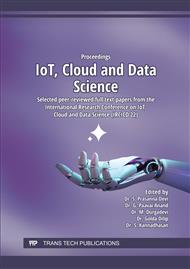[1]
Ahmed, M., M.T. lmtiaz, and R. Khan, 2018, Movie recommendation system using clustering and pattern recognition network,, IEEE 8th Annual Computing and Communication Workshop and Conference (CCWC) IEEE.
DOI: 10.1109/ccwc.2018.8301695
Google Scholar
[2]
Al-Bakri, N.F. and S.H. Hashim, 2018, Reducing Data Sparsity in Recommender Systems,. Al-Nahrain Journal of Science, vol. 21, no.02, p.138–147.
DOI: 10.22401/jnus.21.2.20
Google Scholar
[3]
Chen, J, 2018, An Implicit Information Based Movie Recommendation Strategy,. IEEE SmartWorld, Ubiquitous intelligence & Computing, Advanced & Trusted Computing, Scalable Computing & Communications, Cloud & Big Data Computing, Internet of People and Smart City innovation (SmartWorld/SCALCOM/UlC/ATC/CBDCom/lOP/SCl) IEEE.
DOI: 10.1109/smartworld.2018.00098
Google Scholar
[4]
Dhruv A, 2019, Artist Recommendation System Using Hybrid Method: A Novel Approach,, Emerging Research in Computing, Information, Communication and Applications, Springer. p.527–542.
DOI: 10.1007/978-981-13-5953-8_44
Google Scholar
[5]
C. Hongliang, Q. Xiaona, 2015, The Video Recommendation System Based on DBN,, IEEE International Conference on Computer and Information Technology; Ubiquitous Computing and Communications; Dependable, Autonomic and Secure Computing; Pervasive Intelligence and Computing, pp.1016-1021,.
DOI: 10.1109/cit/iucc/dasc/picom.2015.154
Google Scholar
[6]
Katarya, R. O.P. Verma, 2017, An effective collaborative movie recommender system with cuckoo search,, Egyptian informatics Journal, vol.18, no.02, p.105–112. https://doi.org/10.1016/j.eij.2016.10.002.
DOI: 10.1016/j.eij.2016.10.002
Google Scholar
[7]
Kluver, D., M.D. Ekstrand, J.A. Konstan, 2018, Rating-based collaborative filtering: algorithms and evaluation,, Social Information Access, Springer. p.344–390.
DOI: 10.1007/978-3-319-90092-6_10
Google Scholar
[8]
Liao, C.-L, S.-J. Lee, 2016, A clustering based approach to improving the efficiency of collaborative filtering recommendation,, Electronic Commerce Research and Applications, vol.18, p.1–9. https://doi.org/10.1016/j.elerap.2016.05.001.
DOI: 10.1016/j.elerap.2016.05.001
Google Scholar
[9]
Lin, C.-Y., L.-C. Wang, K.-H. Tsai, 2018, Hybrid real-time matrix factorization for implicit feedback recommendation systems,, IEEE Access, vol.6, p.21369–21380. https://doi.org/10.1109/ACCESS.2018.2819428.
DOI: 10.1109/access.2018.2819428
Google Scholar
[10]
Mahata, A, 2016, Intelligent movie recommender system using machine learning,, International Conference on Intelligent Human Computer Interaction. Springer.
Google Scholar
[11]
Mishra, N, 2017, Solving Sparsity Problem in Rating-Based Movie Recommendation System,, Computational Intelligence in Data Mining, Springer. p.111–117.
DOI: 10.1007/978-981-10-3874-7_11
Google Scholar
[12]
Sappadla, P., Y. Sadhwani, P. Arora, 2017, Movie Recommender System,, Search Engine Architecture, Spring.
Google Scholar
[13]
Shrivastava, R. H. Singh, 2017, K-means clustering based solution of sparsity problem in rating based movie recommendation system,. International Journal of Engineering and Management Research (IJEMR), vol.07, no.02, p.309–314.
Google Scholar
[14]
Subramaniam, R., R. Lee, T. Matsuo, 2017, Movie Master: Hybrid Movie Recommendation,, International Conference on Computational Science and Computational Intelligence (CSCl). IEEE.
DOI: 10.1109/csci.2017.56
Google Scholar
[15]
Yi, B, 2019, Deep matrix factorization with implicit feedback embedding for recommendation systems,, IEEE Transactions on industrial informatics, vol.15, no.08, p.4591–4601. https://doi.org/10.1109/TII.2019.2893714.
DOI: 10.1109/tii.2019.2893714
Google Scholar
[16]
Zhou, T., L. Chen, J. Shen, 2017 Movie Recommendation System Employing the User-Based CF in Cloud Computing,, IEEE International Conference on Computational Science and Engineering (CSE) and IEEE International Conference on Embedded and Ubiquitous Computing (EUC), IEEE.
DOI: 10.1109/cse-euc.2017.194
Google Scholar


